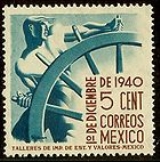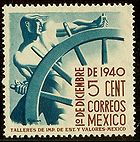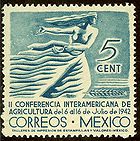
Francisco Eppens Helguera
Encyclopedia

Postage stamps and postal history of Mexico
Mexico's postal system has its roots in the Aztec system of messengers which the Spanish adopted after the Conquest. During the 18th century, Spain established a formal postal system with regular routes. In 1856, Mexico issued its first adhesive postage stamps, with "district overprints", a...
and revenue stamp
Revenue stamp
A revenue stamp, tax stamp or fiscal stamp is a adhesive label used to collect taxes or fees on documents, tobacco, alcoholic drinks, drugs and medicines, playing cards, hunting licenses, firearm registration, and many other things...
s (1935–1953) and for his 1968 redesign of the Mexican coat of arms, still used today on Mexican government documents, coins
Mexican peso
The peso is the currency of Mexico. Modern peso and dollar currencies have a common origin in the 15th–19th century Spanish dollar, most continuing to use its sign, "$". The Mexican peso is the 12th most traded currency in the world, the third most traded in the Americas, and by far the most...
and the national flag
Flag of Mexico
The flag of Mexico is a vertical tricolor of green, white, and red with the national coat of arms charged in the center of the white stripe. While the meaning of the colors has changed over time, these three colors were adopted by Mexico following independence from Spain during the country's War...
.
Biography
Eppens' paternal grandfather, Adolfo Dietrich Eppens, was born in BaselBasel
Basel or Basle In the national languages of Switzerland the city is also known as Bâle , Basilea and Basilea is Switzerland's third most populous city with about 166,000 inhabitants. Located where the Swiss, French and German borders meet, Basel also has suburbs in France and Germany...
, Switzerland, and moved to Mexico in 1863, where he married Eloísa Campillo of Hermosillo
Hermosillo
Hermosillo is a city and municipality located centrally in the northwestern Mexican state of Sonora. It is the capital and main economic center for the state and region. It contains almost all of the state's manufacturing and has thirty percent of its population...
, Sonora
Sonora
Sonora officially Estado Libre y Soberano de Sonora is one of the 31 states which, with the Federal District, comprise the 32 Federal Entities of Mexico. It is divided into 72 municipalities; the capital city is Hermosillo....
. They moved to Switzerland where Francisco Eppens Campillo, the artist's father, was born in 1888. Subsequently, the family relocated to San Luis Potosi
San Luis Potosí
San Luis Potosí officially Estado Libre y Soberano de San Luis Potosí is one of the 31 states which, with the Federal District, comprise the 32 Federal Entities of Mexico. It is divided in 58 municipalities and its capital city is San Luis Potosí....
, Mexico, where they operated a hardware business. The artist's father married Mercedes Helguera (b. 1884) of San Luis Potosí, Mexico, where Eppens was born on February 1, 1913.
In 1920, the family moved to Mexico City, where Eppens received his primary education. In 1927, he enrolled in a bachellor's degree program in engineering and architecture at the Escuela Nacional Preparatoria of the National Autonomous University of Mexico
National Autonomous University of Mexico
The Universidad Nacional Autónoma de México is a university in Mexico. UNAM was founded on 22 September 1910 by Justo Sierra as a liberal alternative to the Roman Catholic-sponsored Royal and Pontifical University of Mexico The Universidad Nacional Autónoma de México (UNAM) (National Autonomous...
. Eppens left that program, however, and the following year studied painting and sculpture at the "Escuela de Artes Plásticas" (School of Fine Arts) of the Academia de San Carlos. For a few years, Eppens designed advertisements and posters, and starting in 1930 he worked at the Industria Cinematográfica Nacional as an artist.
In 1947 he married María Lascurain Segovia, with whom he had three children. He died in Mexico City on September 6, 1990.
Postage stamp designs
In 1935, Eppens was employed by the Mexican government office which produced postage stamps and government securities, the Talleres de Impresión de Estampillas y Valores de México. Between 1935 and 1951, he designed a large number of postage and revenueRevenue stamp
A revenue stamp, tax stamp or fiscal stamp is a adhesive label used to collect taxes or fees on documents, tobacco, alcoholic drinks, drugs and medicines, playing cards, hunting licenses, firearm registration, and many other things...
stamps in a modernist or Art Deco
Art Deco
Art deco , or deco, is an eclectic artistic and design style that began in Paris in the 1920s and flourished internationally throughout the 1930s, into the World War II era. The style influenced all areas of design, including architecture and interior design, industrial design, fashion and...
style. Representative examples are the Helmsman stamp from 1940, issued in connection with the Inauguration of Mexican President Manuel Avila Camacho
Manuel Ávila Camacho
Manuel Ávila Camacho served as the President of Mexico from 1940 to 1946.Manuel Ávila was born in the city of Teziutlán, a small town in Puebla, to middle-class parents, Manuel Ávila Castillo and Eufrosina Camacho Bello. He had several siblings, among them sister María Jovita Ávila Camacho and...
, or the Wheat Sower stamp from 1942, issued to commemorate an international agricultural conference.

Malaria
Malaria is a mosquito-borne infectious disease of humans and other animals caused by eukaryotic protists of the genus Plasmodium. The disease results from the multiplication of Plasmodium parasites within red blood cells, causing symptoms that typically include fever and headache, in severe cases...
. His stamp designs were popular internationally, receiving awards for "one of the best 10 stamps in the world" (1939) and "one of the six best stamps in the world" (1940), both awarded by Scott's Monthly Stamp Journal
Scott catalogue
The Scott catalogue of postage stamps, published by Scott Publishing Co, a subsidiary of Amos Press, is updated annually and lists all the stamps of the entire world which its editors recognize as issued for postal purposes. It is published in six large volumes and is also produced in...
, and an exhibition of his stamps was held at the Collectors Club of New York
Collectors Club of New York
The Collectors Club of New York, often referred to as the Collectors Club, is a private club and philatelic society in New York City. Founded in 1896, it is one of the oldest existing philatelic societies in the United States...
in 1944.
In 2009, an exhibition of his stamps with original drawings and paintings was held in Oaxaca, Mexico, and a full length study of his stamp designs in the exhibit was published.
Paintings and Murals
In 1940, Eppens became associated with the "Escuela Mexicana del Realismo Critico" characterized by nationalistic themes, and also joined the Rancho del Artista group where he met Diego RiveraDiego Rivera
Diego María de la Concepción Juan Nepomuceno Estanislao de la Rivera y Barrientos Acosta y Rodríguez was a prominent Mexican painter born in Guanajuato, Guanajuato, an active communist, and husband of Frida Kahlo . His large wall works in fresco helped establish the Mexican Mural Movement in...
and other artists. In 1950, he became part of the group known as the Frente Nacional de Artes Plásticas, and in the late 1970s joined the group called Pictórico Contemporáneo A.C.
In the 1940s and 1950s, Eppens painted many murals in the interiors of institutional buildings. In the 1960s, he created similar glass mosaic murals for the exteriors of buildings, as well as some large metal sculptures. In the 1970s and 1980s he primarily created paintings.
Eppens' artistic style is characteristic of the Mexican Mural
Renaissance
Mexican Muralism
Mexican muralism is a Mexican art movement. The most important period of this movement took place primarily from the 1920s to the 1960s, though it exerted an influence on later generations of Mexican artists...
and his works commonly feature characteristic Mexican themes such as Aztec and colonial architecture, scenes of folk life, farm animals, the Mexican eagle and symbol of the country, and Catholic images.
Eppens' best known art works include:
Paintings
- Alcatraces (Cala lilies), 1965
- Contrafuertes Coloniales (Colonial buttressesFlying buttressA flying buttress is a specific form of buttressing most strongly associated with Gothic church architecture. The purpose of any buttress is to resist the lateral forces pushing a wall outwards by redirecting them to the ground...
), 1971 - Arquitectura Prehispánica (Pre-Hispanic buildings), 1983
- La Danza de la Media Luna (Dance of the half moon), 1984
- Las Hermanas (The sisters), 1988
Murals
- Faculty of Medicine at the National University of Mexico in Mexico City, 1952 Image
- La Revolución, Edificio del Partido Revolucionario Institucional, 1963.
Sculpture
- La Industria Nacional del Acero (The National Steel Industry), Bruno Pagliai Industrial City, Veracruz, 1973-74.
Mexican coat of arms

Mexican peso
The peso is the currency of Mexico. Modern peso and dollar currencies have a common origin in the 15th–19th century Spanish dollar, most continuing to use its sign, "$". The Mexican peso is the 12th most traded currency in the world, the third most traded in the Americas, and by far the most...
and the national flag
Flag of Mexico
The flag of Mexico is a vertical tricolor of green, white, and red with the national coat of arms charged in the center of the white stripe. While the meaning of the colors has changed over time, these three colors were adopted by Mexico following independence from Spain during the country's War...
.
Exhibitions
Eppens' work was shown in various collective exhibitions over the years, including a group exhibit at the Museum of Modern ArtMuseum of Modern Art
The Museum of Modern Art is an art museum in Midtown Manhattan in New York City, on 53rd Street, between Fifth and Sixth Avenues. It has been important in developing and collecting modernist art, and is often identified as the most influential museum of modern art in the world...
in New York City in 1930, but with the exception of the 1944 exhibit of his stamps, he did not have solo exhibits until the 1980s:
- Collectors Club of New York, New York City, 1944.
- "Exposición Individual de Pinturas, Dibujos y Monotipos", Hotel Cancún Sheraton, Cancún, 1983.
- "Francisco Eppens: Pintor, Escultor y Muralista", Instituto Cultural Cabañas, Guadalajara, 1987.
- "Francisco Eppens: Pintor, Escultor y Muralista", Museo del Palacio de Bellas Artes, Mexico City, 1987.
- "El Mural Mexicano: Homenaje a Francisco Eppens", Edificio de la Sede del Partido Revolucionario Institutional, Mexico City, 1989.
- "Francisco Eppens, Artista Potosino", Instituto Potosino de Bellas Artes, Mexico City, 1990.
- "Francisco Eppens: Pintor, Escultor y Muralista", Casa de Cultura, San Luis Potosi, 1993.
- "Exposición - Homenaje del Artista Francisco Eppens", Secretaria de Gobernación, Mexico City, 1996.
- "Francisco Eppens, Pintor Muralista", Museo de Arte de Querétaro, Querétaro, 1999.
- "Francisco Eppens, Pintor Muralista", Edifico de la Real Caja, Centro Cultural Universitario, San Luis Potosi, 1999.
- "Los Potosinos y los Simbolos Patrios", Museo de la Cultura Potosina, San Luis Potosi, 2000.
- "Exposición - Homenaje del Artista Francisco Eppens", Edificio del Senado de la República, Mexico City, 2000.
- "Eppens: Mensajeros del Mexico Moderno", Museo de Filatelia de Oaxaca, Oaxaca, 2009. Exhibit of stamps designed by Eppens, with original drawings and paintings.
See also
- Postage stamps and postal history of Mexico.
- Art Deco stampsArt Deco stampsArt deco stamps are postage stamps designed in the Art Deco style which was a popular international design style in the 1920s through the 1930s. The style is marked by the use of "geometric motifs, curvilinear forms, sharply defined outlines, often bold colors", and a fascination with machinery...
.
External links
- Julieta Ortiz Gaitán, Francisco Eppens y los mensajeros del México moderno Eppens' stamp designs, with many images.
Sources
- Francisco Eppens (1913-1990), Fondo Cultural Carmen A.C., México, D.F., 2001. Exhibition catalog.
- Francisco Eppens: muralista, pintor y esculptor, Museo del Palacio de Bellas Artes, México, D.F., 1987. Exhibition catalog.
- Julieta Ortiz Gaitán, Mensajeros Del México Moderno: Timbres Postales Y Fiscales De Francisco Eppens En Los Tallares De Impresión De Estampillas Y Valores, Museo de Filatelia de Oaxaca (MUFI)/Fundación Alfredo Harp Helú, 2009.
- Ramón Valdiosera Berman, Francisco Eppens: el hombre, su arte y su tiempo, Universidad Nacional Autónoma de México, México, D.F., 1988. Includes a catalog of Eppens' stamps.

